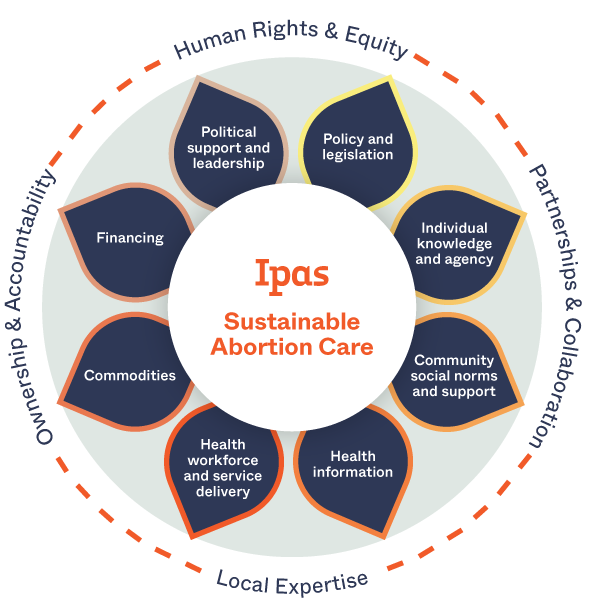Last reviewed: September 15, 2022
Recommendation:
- Routine use of antibiotics is not recommended for medical abortion.
- Administer treatment doses of antibiotics to those with signs or symptoms of sexually transmitted infection. Partners of individuals with sexually transmitted infections also require treatment. Treatment should not delay medical abortion.
Strength of recommendation: Strong
Quality of evidence: Very low
Risk of infection
The overall risk of infection found in prospective studies of medical abortion using mifepristone and a prostaglandin before 13 weeks gestation is approximately 0.01-0.5% (Achilles & Reeves, 2011; Chen & Creinin, 2015; Upadhyay et. al, 2015). Serious infections requiring hospitalization are very uncommon, with rates in large retrospective studies from the United States ranging from 0.03% to 0.09% (Fjerstad et al., 2009; Henderson et al., 2005).
Infection rates for medical abortion at or after 13 weeks gestation are more difficult to determine as fever is a common side effect of repeated doses of prostaglandin. Available data report infection rates of 1-3% following medical abortion at or after 13 weeks gestation (Achilles & Reeves, 2011).
Infectious mortality
Nine cases of fatal Clostridium sepsis occurred in North America following mifepristone and misoprostol medical abortion before 13 weeks gestation (Cohen et al., 2007; Fischer et al., 2005; Meites, Zane, & Gould, 2010; Sinave et al., 2002). One death from group A streptococcus has been reported in Australia and one death from Clostridium sordelli has been reported in Portugal (Reis et al., 2011) in women who used mifepristone and misoprostol. The overall mortality rate from infection related to medical abortion remains very low at 0.58 per 100,000 medical abortions (Meites et al., 2010).
Prophylactic antibiotics
There have been no randomized controlled trials examining the effect of antibiotic prophylaxis on medical abortion outcomes (Achilles & Reeves, 2011; Low et al., 2012). Given the large number of people who would need to take antibiotics to prevent a single infection, coupled with the expense and side effects of antibiotics, the American College of Obstetricians and Gynecologists (2020), the Society of Family Planning (Achilles & Reeves, 2011), the Royal College of Obstetricians and Gynaecologists (2022) and the World Health Organization (WHO, 2022) do not recommend routine antibiotic use prior to medical abortion.
Therapeutic antibiotics
Those women at high risk should be screened for sexually transmitted infections. Individuals who have signs and symptoms of sexually transmitted infection should be provided abortion services without delay and receive appropriate antibiotic treatment according to evidence-based regimens (WHO, 2022; WHO, 2021). Partners of individuals with sexually transmitted infections also require treatment (WHO, 2016).
Resources
Recommendations for use of prophylactic antibiotics in safe abortion care (card)
References
Achilles, S. L., & Reeves, M. F. (2011). Society of Family Planning Clinical Guideline 20102: Prevention of infection after induced abortion. Contraception, 83(4), 295-309.
American College of Obstetricians and Gynecologists. (2020). Practice Bulletin No. 225: Medication abortion up to 70 days of gestation. Obstetrics & Gynecology, 136:e31-47.
Chen, M. J., & Creinin, M. D. (2015). Mifepristone with buccal misoprostol for medical abortion: A systematic review. Obstetrics & Gynecology, 126(1), 12-21.
Cohen, A. L., Bhatnagar, J., Reagan, S., Zane, S. B., D’Angeli, M. A., Fischer, M., … McDonald, L. C. (2007). Toxic shock associated with Clostridium sordellii and Clostridium perfringens after medical and spontaneous abortion. Obstetrics & Gynecology, 110(5), 1027-1033.
Fischer, M., Bhatnagar, J., Guarner, J., Reagan, S., Hacker, J. K., Van Meter, S. H., & Zaki, S. R. (2005). Fatal toxic shock syndrome associated with Clostridium sordellii after medical abortion. New England Journal of Medicine, 353(22), 2352-2360.
Fjerstad M., Trussell J., Sivin I., Lichtenberg E.S., & Cullins V. (2009). Rates of serious infection after changes in regimens for medical abortion. New England Journal of Medicine, 361(2), 145-51.
Henderson, J. T., Hwang, A. C., Harper, C. C., & Stewart, F. H. (2005). Safety of mifepristone abortions in clinical use. Contraception, 72(3), 175-178.
Low, N., Mueller, M., Van Vliet, H., & Kapp, N. (2012). Perioperative antibiotics to prevent infection after first‐trimester abortion. The Cochrane Database of Systematic Reviews (3), CD005217.
Meites, E., Zane, S., & Gould, C. (2010). Fatal Clostridium sordellii infections after medical abortions. New England Journal of Medicine, 363(14), 1382-1383.
Reis, T., Chaves, C., Soares, A., Moreira, M., Boaventura, L., & Ribiero, G. (2011). A Clostridium sordellii fatal toxic shock syndrome post-medical-abortion in Portugal. Paper presented at the 21st European Congress of Clinical Microbiology and Infectious Diseases (ECCMID).
Royal College of Obstetricians and Gynaecologists. (2022). Best practice inabortion care. London: Royal College of Obstetricians and Gynaecologists Press.
Sinave, C., Le Templier, G., Blouin, D., Leveille, F., & Deland, E. (2002). Toxic shock syndrome due to Clostridium sordellii: A dramatic postpartum and postabortion disease. Clinical Infectious Diseases, 35(11), 1441-1443.
Upadhyay, U. D., Desai, S., Zlidar, V., Weitz, T. A., Grossman, D., Anderson, P., & Taylor, D. (2015). Incidence of emergency department visits and complications after abortion. Obstetrics & Gynecology, 125(1), 175-83.
World Health Organization. (2022). Abortion Care Guideline. Geneva: World Health Organization.
World Health Organization. (2016). Global health sector strategy on sexually transmitted infections 2016-2021. Geneva: World Health Organization.
World Health Organization. (2021). Guidelines for the management of symptomatic sexually transmitted infections. Geneva: World Health Organization Press.
